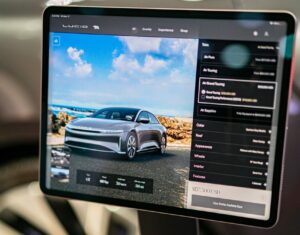
Home / EV Charging News / Electric Cars and Shared Mobility Platforms
Consumer education initiatives play a pivotal role in shaping perceptions and driving adoption of electric vehicles (EVs). In this article, we delve into the importance of consumer education programs in increasing awareness and fostering adoption of electric cars.
Consumer education efforts aim to demystify electric vehicles by providing clear and accessible information about their technology, benefits, and considerations. By addressing common misconceptions and highlighting the advantages of EVs, consumers can make informed decisions about their transportation choices.
One of the key messages of consumer education programs is the environmental benefits of electric cars. By emphasizing the reduction in greenhouse gas emissions and air pollution associated with EVs, consumers gain an understanding of the positive impact their transportation choices can have on the environment.
Consumer education programs address concerns such as range anxiety by providing accurate information about the range capabilities of electric vehicles and highlighting the availability of charging infrastructure. By dispelling myths about limited range, consumers gain confidence in the practicality of EVs for their daily needs.
Another common misconception is the perceived lack of charging infrastructure for electric vehicles. Consumer education initiatives educate consumers about the growing network of charging stations, the convenience of home charging, and the advancements in fast-charging technology, alleviating concerns about accessibility.
Consumer education efforts highlight the long-term cost savings associated with electric vehicles, including lower fuel and maintenance costs compared to traditional gasoline-powered cars. By illustrating the financial benefits of EV ownership, consumers are motivated to consider electric cars as a viable option.
Consumer education programs inform consumers about government incentives and rebates available for electric vehicle purchases, such as tax credits, grants, and rebates for home charging installations. By maximizing available incentives, consumers can further reduce the upfront cost of EV ownership.
Consumer education initiatives emphasize the role of electric vehicles in mitigating climate change and reducing dependence on fossil fuels. By framing EV adoption as a tangible action individuals can take to contribute to a sustainable future, consumers are inspired to make environmentally conscious choices.
Another focus of consumer education programs is the impact of electric vehicles on air quality improvement in urban areas. By highlighting the health benefits of reducing tailpipe emissions, such as lower rates of respiratory illnesses, consumers understand the importance of transitioning to cleaner transportation options.
Consumer education initiatives facilitate test drive opportunities for consumers to experience electric vehicles firsthand. By providing hands-on experiences and allowing consumers to explore the performance and features of EVs, barriers to adoption are lowered, and interest in electric cars is heightened.
Online resources and tools, such as EV comparison websites and calculators, empower consumers to research and compare electric vehicles based on their needs and preferences. By providing access to comprehensive information, consumers can make educated decisions about which EV best suits their lifestyle.
Consumer education efforts are often a collaborative endeavor involving automakers, government agencies, advocacy groups, and non-profit organizations. By pooling resources and expertise, stakeholders can amplify their impact and reach a broader audience with consistent and accurate messaging about electric vehicles.
Community engagement initiatives, such as EV awareness events and workshops, foster dialogue and interaction between consumers and EV experts. By creating opportunities for peer-to-peer learning and sharing experiences, communities become more informed and supportive of electric vehicle adoption.
Incorporating electric vehicles into car-sharing fleets enhances the sustainability of these services. Electric car-sharing programs offer users access to eco-friendly transportation options for short-term use, reducing reliance on traditional gasoline-powered vehicles.
Ride-hailing companies are increasingly transitioning to electric vehicles to reduce emissions and promote sustainable transportation. The integration of electric cars into ride-hailing fleets provides passengers with environmentally friendly transportation choices and contributes to cleaner urban air.
Electric vehicles offer significant environmental advantages over traditional internal combustion engine vehicles. By producing zero tailpipe emissions, EVs help mitigate air pollution and reduce greenhouse gas emissions, contributing to cleaner and healthier cities.
Shared mobility operators stand to benefit from the cost efficiency of electric vehicles. With lower operating costs, including reduced fuel and maintenance expenses, electric cars offer financial savings over the lifetime of the vehicle, enhancing the economic viability of shared mobility services.
Expanding charging infrastructure is crucial for supporting the widespread adoption of electric vehicles in shared mobility. Shared mobility operators must invest in the development of charging stations and infrastructure to meet the charging needs of their electric vehicle fleets.
Range anxiety remains a concern for users of electric vehicles in shared mobility. Operators need to address these concerns by ensuring adequate charging infrastructure, educating users about EV range capabilities, and implementing strategies to alleviate range anxiety.
Promoting shared rides in both car-sharing and ride-hailing services is key to maximizing sustainability. By encouraging passengers to share trips, shared mobility operators can reduce the number of vehicles on the road, minimize congestion, and optimize resource utilization.
Collaboration with public transit agencies facilitates seamless integration between shared mobility services and public transportation. By providing first and last-mile connectivity solutions, shared mobility platforms complement existing transit networks, making sustainable transportation more accessible and convenient.
The integration of electric vehicles into shared mobility platforms represents a significant step towards sustainable urban transportation. By leveraging the environmental and economic benefits of EVs and implementing strategies to overcome challenges, shared mobility operators can maximize sustainability and contribute to building cleaner, greener cities. As electric mobility continues to evolve, shared mobility platforms have the potential to play a central role in shaping the future of urban transportation.
$4,150.00 Original price was: $4,150.00.$3,990.00Current price is: $3,990.00.
$10,690.00 – $11,390.00

Your Power Management Partner for Over 25 Years Future Generations Depend on Our Decisions Today ™
2024 © All rights reserved by CyberSwitching